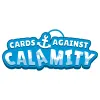Take a look inside 12 images
Cards Against Calamity
Pros: Easy to learn, quick to play, and the inherent lessons will spur important discussion.
Cons: Lacks accompanying teacher resources and variety in gameplay.
Bottom Line: A fun, quick way to initiate discussion on how to keep communities resilient in order to withstand and recover from natural disasters.
Cards Against Calamity, a simple but interesting game, drives home the point of needing to balance resources to keep all aspects of a community thriving in order to withstand natural disasters. It's a perfect launchpad for further discussion and related lessons (e.g., exploring how scientists use scientific research to make similar choices). Tough decisions and compromises are things students will have to deal with in their future, and this game demonstrates that well. Because the game can be played fairly quickly (especially at the easier levels), teachers can use it as a whole-class activity. Students can vote on or debate which choice to make at each turn, and then see the effects of those choices. Teachers can also challenge students to create the most resilient communities they can by playing the game on their own, either on class devices or for homework.
Cards Against Calamity is a web-based game (nominated for Best Learning Game for the 2019 Games for Change awards) where players take on the role of mayor of a small coastal town who must make a series of choices to balance community needs while also keeping the community resilient enough to withstand a natural disaster. Players choose their region (Pacific, Gulf of Mexico, and New England are currently accessible) and then their difficulty level (1-5). Gameplay includes eight stages, which don't seem to have any real significance other than to reflect game progress.
As the game starts, the player has just been elected as mayor. Students have a modest budget surplus and must decide how to spend it. From there, students make a series of either/or choices (though sometimes there are three options), keeping the community's resiliency in balance. Service workers, fishing industry, tourism, business and trade, and social approval are affected by player decisions, as is a general resiliency pool that can be built up and drawn upon when other areas lose resiliency. The interface also includes a social feed, which seems to be just color commentary and doesn't have an effect on the game.
Students will need to make choices about taxes, development, the harbor, the fishing industry, shopping and tourism, emergency services, and more. Small disasters come along from time to time, but players must keep their town resilient enough so that, at the end of the game when a major natural disaster hits, the town has a chance to survive it.
The point of Cards Against Calamity is for students to learn how a community's resiliency can help it withstand a disaster. This comes into play when students, as mayor, must maintain a balance across the town interests and also must make compromises (sometimes making choices against their natural inclinations) to keep the community resilient.
Some examples of choices to make are: Create a fish hatchery or improve small businesses downtown, improve the power grid or improve the roads, and host a town hall or talk with constituents individually around town. Sometimes students will have an easy decision about where to spend the community's money and effort, but sometimes the given options are equally important. Students will need to examine current resiliency levels to help them make decisions, but there's often no "right" answer. Sometimes students end up making choices they wouldn't ordinarily make because they need to maintain the community's resilience. Disasters can destroy communities even when those in charge do their best to make the right decisions, and this game can reflect that.
Once students have played this game a few times, they'll have learned its inherent lessons. A lot of the quandaries and choices are repeated from one game to the next, even when choosing different geographic regions, so, while the game is very useful for generating discussion and leading off a lesson, it doesn't have much replayability.





















